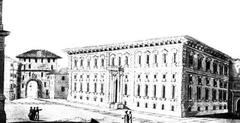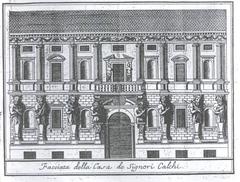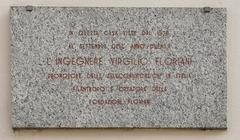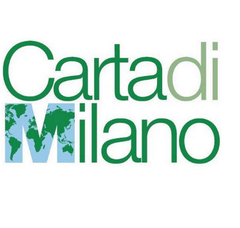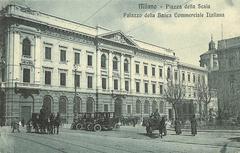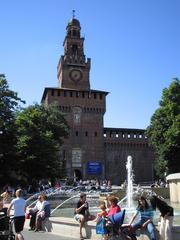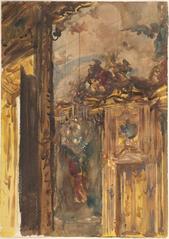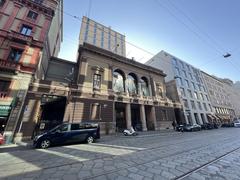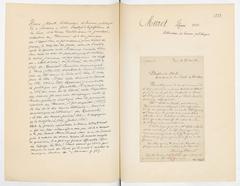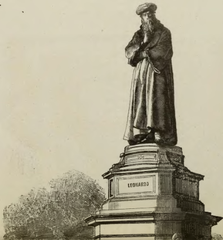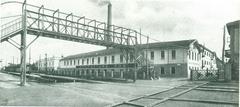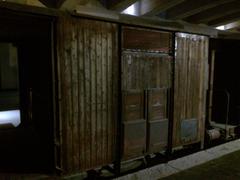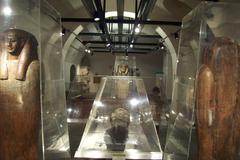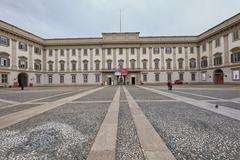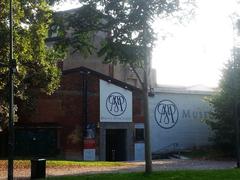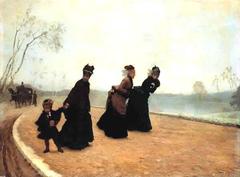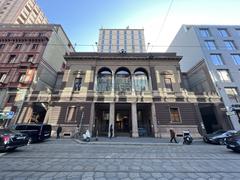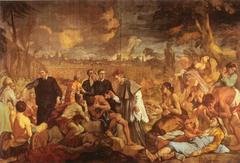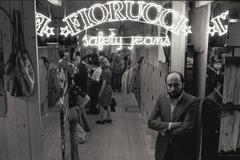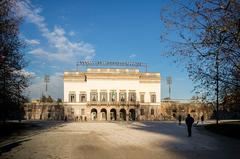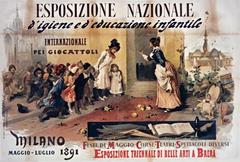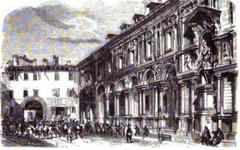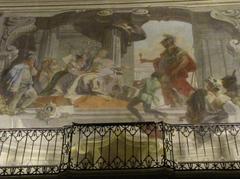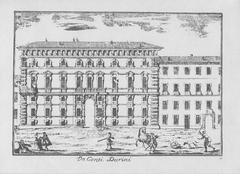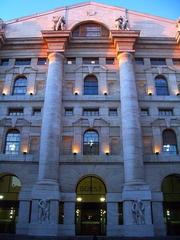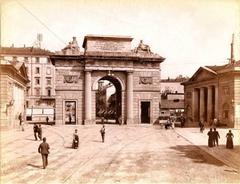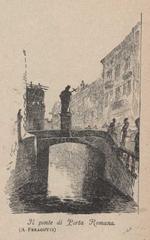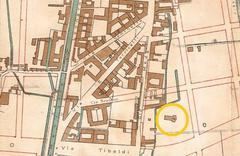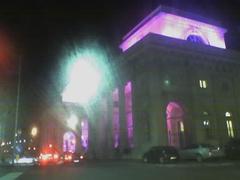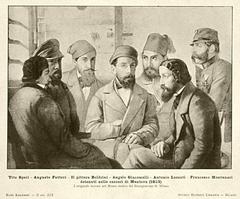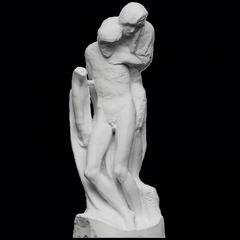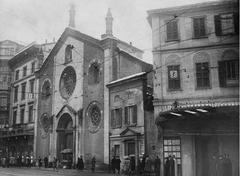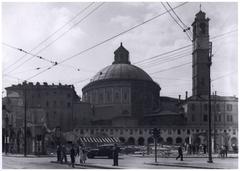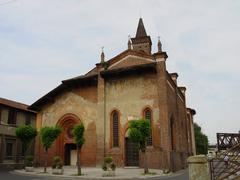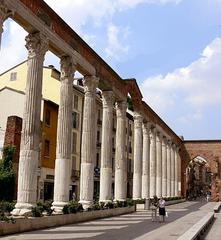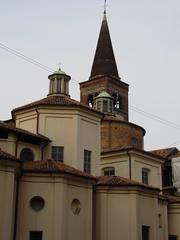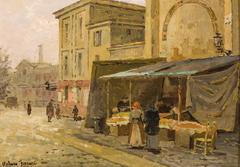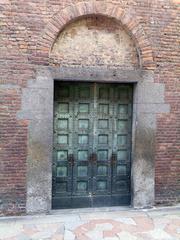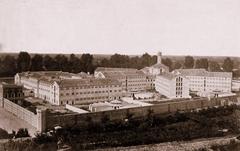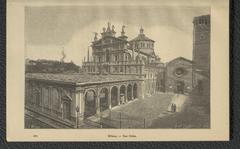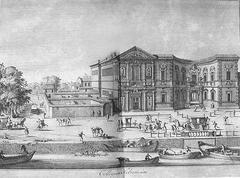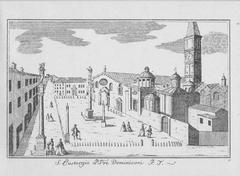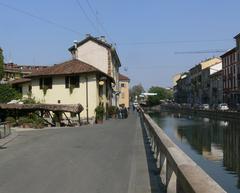
मिलान, इटली में सेंट’अम्ब्रोसियो की यात्रा के लिए व्यापक गाइड
परिचय
मिलान के केंद्र में स्थित, सेंट’अम्ब्रोसियो की बेसिलिका सदियों से चली आ रही धार्मिक भक्ति, स्थापत्य महारत और सांस्कृतिक पहचान का एक असाधारण प्रमाण है। 379 ईस्वी में सेंट एम्ब्रोस द्वारा स्थापित, यह ऐतिहासिक बेसिलिका शहर के सबसे पुराने और सबसे सम्मानित पवित्र स्थलों में से एक है। एक ईसाई कब्रिस्तान पर इसकी उत्पत्ति और संत गेर्वसियस और प्रोसियस जैसे शहीदों का विश्राम इसे गहरा आध्यात्मिक महत्व प्रदान करता है। समय के साथ, सेंट’अम्ब्रोसियो वास्तुशिल्पीय रूप से विकसित हुआ है - प्रारंभिक ईसाई नींव से लेकर 11वीं और 12वीं शताब्दी में इसके परिवर्तनकारी रोमनस्क पुन: निर्माण तक, और बाद में पुनर्जागरण और बारोक प्रभावों तक - इसे मिलान के इतिहास और कला का एक समृद्ध ताना-बाना बनाते हुए।
आज, आगंतुक न केवल पूजा के एक पवित्र स्थान का अनुभव करते हैं, बल्कि एक सांस्कृतिक खजाना भी पाते हैं, जिसमें प्रतिष्ठित ईंट मुखौटा, असममित घंटाघर और शांत खुला प्रांगण जैसी उल्लेखनीय रोमनस्क वास्तुकला शामिल है। कलात्मक आकर्षणों में 13वीं शताब्दी का एप्सीड मोज़ेक जिसमें मसीह बैठे हुए हैं, 9वीं शताब्दी में निर्मित स्वर्ण वेदी, और चर्च में पाए जाने वाले जटिल मूर्तिकला वाले कैपिटल्स शामिल हैं। बेसिलिका की भूमिका वास्तुकला और कला से कहीं आगे तक जाती है; यह एक जीवंत तीर्थ स्थल बना हुआ है, जिसमें सेंट एम्ब्रोस और प्रारंभिक ईसाई शहीदों के अवशेष हैं, और यह सेंट एम्ब्रोस के पर्व सहित महत्वपूर्ण धार्मिक समारोहों का आयोजन करना जारी रखता है।
यह व्यापक मार्गदर्शिका आपको बेसिलिका डि सेंट’अम्ब्रोसियो के दर्शन के समय, टिकट नीतियों, पहुंच के विकल्पों, निर्देशित पर्यटन और व्यावहारिक यात्रा युक्तियों के बारे में आवश्यक जानकारी प्रदान करेगी। इसके अतिरिक्त, यह मिलान के नागरिक और सांस्कृतिक महत्व में बेसिलिका की भूमिका, साथ ही मिलान कैथेड्रल और सेंट’अम्ब्रोसियो संग्रहालय जैसे आस-पास के आकर्षणों के लिए सिफारिशों की पड़ताल करती है। चाहे आप इतिहास के शौकीन हों, वास्तुकला के प्रशंसक हों, या आध्यात्मिक संवर्धन की तलाश में तीर्थयात्री हों, यह मार्गदर्शिका आपको सेंट’अम्ब्रोसियो के कालातीत आकर्षण में खुद को डुबोने के लिए आमंत्रित करती है और यह बताती है कि यह मिलान की ऐतिहासिक पहचान का आधार क्यों बनी हुई है (बेसिलिका डि सेंट’अम्ब्रोसियो - स्टोरिया; ट्रिपवेंचर; मिलानटिप्स)।
सामग्री तालिका
- ऐतिहासिक अवलोकन
- वास्तुशिल्प और कलात्मक मुख्य आकर्षण
- आगंतुक जानकारी
- निर्देशित पर्यटन और कार्यक्रम
- आस-पास के आकर्षण और भोजन
- आगंतुकों के लिए व्यावहारिक सुझाव
- अक्सर पूछे जाने वाले प्रश्न
- निष्कर्ष
- संदर्भ
ऐतिहासिक अवलोकन
स्थापना और प्रारंभिक ईसाई विरासत
सेंट’अम्ब्रोसियो की स्थापना 379 और 386 ईस्वी के बीच मिलान के तत्कालीन बिशप सेंट एम्ब्रोस द्वारा एक ईसाई कब्रिस्तान की साइट पर की गई थी। मूल रूप से बेसिलिका मार्टिरम का नाम दिया गया, इसका उद्देश्य गेर्वसियस और प्रोसियस शहीदों का सम्मान करना था, जिनके अवशेष स्वयं एम्ब्रोस द्वारा बेसिलिका में खोजे और रखे गए थे (बेसिलिका सेंट’अम्ब्रोसियो - स्टोरिया; एटी-मिलान.ओआरजी)। एम्ब्रोस के 397 ईस्वी में खुद बेसिलिका में दफन होने के बाद, चर्च जल्दी से मिलान की ईसाई पहचान का केंद्र बन गया।
मध्यकालीन और रोमनस्क परिवर्तन
मध्य युग के दौरान, सेंट’अम्ब्रोसियो ने रूप और कार्य दोनों में विकास किया। 11वीं और 12वीं शताब्दी में सबसे महत्वपूर्ण परिवर्तन हुआ, जब बेसिलिका का रोमनस्क शैली में पुनर्निर्माण किया गया। इस काल से विशिष्ट ईंट मुखौटा, दो असममित घंटाघर - 9वीं शताब्दी का टोरे देई मोनासी और 12वीं शताब्दी का टोरे देई कैनोनिकी - और खुला प्रांगण जो आज आगंतुकों का स्वागत करता है, का उदय हुआ (विकीआर्किटेक्टुरा; स्मार्टहिस्ट्री)। बेसिलिका के मुख्य हॉल और गलियारों का विस्तार किया गया, और एप्स धार्मिक कला का केंद्र बिंदु बन गया, विशेष रूप से इसके मोज़ेक के बाद के जुड़ाव के साथ।
पुनर्जागरण और आधुनिक जीर्णोद्धार
पुनर्जागरण काल में डोनाटो ब्रामांटे जैसे उल्लेखनीय वास्तुकारों के नेतृत्व में चैपल और जीर्णोद्धार प्रयासों को जोड़ा गया। बेसिलिका ने नेपोलियनिक और विश्व युद्ध अवधियों की चुनौतियों का सामना किया, द्वितीय विश्व युद्ध की बमबारी में क्षति हुई लेकिन बाद में बहुत सावधानी से बहाल किया गया। आज, यह पूजा का एक सक्रिय स्थान और मिलान के बहुस्तरीय इतिहास का एक प्रमाण बना हुआ है (बेसिलिका सेंट’अम्ब्रोसियो - स्टोरिया)।
वास्तुशिल्प और कलात्मक मुख्य आकर्षण
रोमनस्क विशेषताएँ और लेआउट
सेंट’अम्ब्रोसियो लोम्बार्ड रोमनस्क वास्तुकला का एक मॉडल है। उल्लेखनीय विशेषताओं में शामिल हैं:
- ईंट मुखौटा: गेबल प्रोफाइल और सुपरिम्पोज़्ड लॉजिया द्वारा विशेषता।
- प्रांगण: 9वीं शताब्दी का एक आयताकार अग्रभाग, जो वाल्टेड गलियारों से घिरा हुआ है, धर्मनिरपेक्ष से पवित्र में एक प्रतीकात्मक सीमा के रूप में कार्य करता है (स्मार्टहिस्ट्री)।
- घंटाघर: टोरे देई मोनासी और टोरे देई कैनोनिकी, प्रत्येक बेसिलिका के मठवासी और नियमित समुदायों के भीतर विभिन्न ऐतिहासिक अवधियों और कार्यों को दर्शाता है (आर्चजर्नी)।
- मुख्य हॉल और गलियारे: इंटीरियर स्तंभों और खंभों, गोल मेहराबों और रिब्ड वॉल्ट के वैकल्पिक लय का दावा करता है जो रोमनस्क शैली पर जोर देते हैं।
कलात्मक खजाने: मोज़ेक, स्वर्ण वेदी, और मूर्तिकला
- एप्स मोज़ेक: 13वीं शताब्दी का मसीह के सिंहासन पर विराजमान मोज़ेक एक मध्यकालीन उत्कृष्ट कृति है, जो अभयारण्य में एक चमकदार केंद्र बिंदु बनाने के लिए जीवंत सोने और रंगों का उपयोग करता है (स्मार्टहिस्ट्री)।
- स्वर्ण वेदी (अल्टेरे डी’ओरो): 835 ईस्वी में वोल्विनीओ द्वारा तैयार की गई यह कैरोलिंगियन उत्कृष्ट कृति कीमती पत्थरों और तामचीनी पैनलों से सजी है, जिसमें मसीह और सेंट एम्ब्रोस के जीवन को दर्शाया गया है, जो एक प्रारंभिक ईसाई सिबोरियम के नीचे सुरक्षित है (एड आर्टेम)।
- स्टिलिचो का मकबरा: बाइबिल के दृश्यों को दर्शाने वाली प्रचुर मात्रा में तराशी गई देर से रोमन सार्कोफैगस, प्रारंभिक ईसाई अंतिम संस्कार कला का एक उत्कृष्ट उदाहरण है (ट्रिपवेंचर)।
- कैपिटल्स और मूर्तिकला: स्तंभों और कैपिटल्स पर जटिल नक्काशी बाइबिल और वनस्पति रूपांकनों को दर्शाती है, जो मध्यकालीन कारीगरों के कौशल का प्रमाण है (स्मार्टहिस्ट्री)।
आगंतुक जानकारी
स्थान और वहाँ कैसे पहुँचें
- पता: पियाज़ा सेंट’अम्ब्रोसियो, 15, 20123 मिलान, इटली
- मेट्रो: लाइन M2 (ग्रीन) और लाइन M4 (ब्लू) - सेंट’अम्ब्रोसियो स्टेशन कुछ ही कदम दूर है (basilicasantambrogio.it)।
- बस: एटीएम लाइन 50, 58, और 94 पास में रुकती हैं (रेनाटोप्रोशियुट्टो.कॉम)।
- पैदल: डुओमो से 15–20 मिनट की पैदल दूरी पर।
बेसिलिका डि सेंट’अम्ब्रोसियो दर्शन घंटे
- बेसिलिका का खुला होना:
- सोमवार–शनिवार: 7:30–12:30, 14:30–19:00
- रविवार/सार्वजनिक अवकाश: 8:00–13:00, 15:00–20:00 (basilicasantambrogio.it)
- पर्यटन घंटे:
- सोमवार–शनिवार: 10:00–12:00, 14:30–18:00
- रविवार/सार्वजनिक अवकाश: 15:00–17:00
- पर्यटन सेवाओं के दौरान अनुमत नहीं है। अपवादों के लिए आधिकारिक अनुसूची देखें।
बंद
- प्रमुख धार्मिक छुट्टियों और चुनिंदा पारिश आयोजनों के दौरान बंद, जिसमें होली थर्सडे, गुड फ्राइडे और ईस्टर की सुबह शामिल है।
टिकट और प्रवेश
- प्रवेश: व्यक्तिगत आगंतुकों के लिए निःशुल्क (हॉलिडीफी.कॉम)।
- सैन विटोर इन सील डी’ओरो चैपल: €1 (केवल नकद); सटीक परिवर्तन लाएं।
- निर्देशित पर्यटन: €10 प्रति व्यक्ति (ऑडियोग्इड शामिल), साथ ही चैपल के लिए €1। एड आर्टेम द्वारा आयोजित, इतालवी और अंग्रेजी में उपलब्ध (एड आर्टेम)।
पहुँच और सुविधाएँ
- व्हीलचेयर पहुँच: मुखौटा के बाईं ओर रैंप उपलब्ध है।
- सहायता: दृष्टि और श्रवण दोषों के लिए बहु-संवेदी पैनल।
- शौचालय: साइट पर सुलभ सुविधाएँ।
- उपहार की दुकान: धार्मिक वस्तुएं और स्मृति चिन्ह उपलब्ध हैं।
- सूचना डेस्क: बहुभाषी कर्मचारी और ब्रोशर।
शिष्टाचार और ड्रेस कोड
- विनम्रता से कपड़े पहनें (कंधे और घुटने ढके हुए)।
- मौन बनाए रखें, खासकर सेवाओं के दौरान।
- फ्लैश के बिना फोटोग्राफी की अनुमति है; कोई ट्राइपॉड नहीं।
- प्रतिबंधित क्षेत्र (जैसे, प्रेस्बिटरी) आगंतुकों के लिए निषिद्ध हैं।
- अंदर खाना, पीना या मोबाइल फोन का उपयोग न करें।
निर्देशित पर्यटन और कार्यक्रम
- पर्यटन: एड आर्टेम द्वारा 90 मिनट के निर्देशित पर्यटन, व्यक्तियों के लिए कोई अग्रिम बुकिंग नहीं; समूह और स्कूलों को आरक्षित करना चाहिए।
- लिटर्जी और पर्व दिवस: दैनिक मास और विशेष कार्यक्रम, जिसमें सेंट एम्ब्रोस का पर्व (7 दिसंबर) शामिल है।
- वार्षिक कार्यक्रम: “फिएरा देगली ओह बेज! ओह बेज!” क्रिसमस बाजार और विशेष जुबली समारोह (आधिकारिक अनुसूची)।
आस-पास के आकर्षण और भोजन
- सेंट’अम्ब्रोसियो संग्रहालय: ऐतिहासिक कलाकृतियों वाला ऑन-साइट संग्रहालय।
- कैथोलिक विश्वविद्यालय ऑफ द सेक्रेड हार्ट: बेसिलिका के बगल में।
- मिलान कैथेड्रल (डुओमो), बेसिलिका डि सैन लोरेंजो मैगिओर, और फोर्टी कैसल: सभी पैदल दूरी पर।
- भोजन: ट्रेटोरिया मिलानीज़ जैसे पास के ट्रेटोरिया में पारंपरिक मिलानीज़ व्यंजन (इटली-टूरिस्ट-सूचना.कॉम)।
आगंतुकों के लिए व्यावहारिक सुझाव
- भीड़ से बचने के लिए जल्दी या देर दोपहर पहुंचें।
- चैपल प्रवेश और दान के लिए नकदी लाएं।
- वर्तमान कार्यक्रम के लिए आधिकारिक बेसिलिका वेबसाइट देखें।
- अन्वेषण के एक पूर्ण दिन के लिए अन्य ऐतिहासिक स्थलों के साथ अपनी यात्रा को मिलाएं (मिलान का परिचय)।
- अपनी वस्तुओं का ध्यान रखें और मौसम के लिए कपड़े पहनें।
अक्सर पूछे जाने वाले प्रश्न (FAQ)
प्रश्न: बेसिलिका डि सेंट’अम्ब्रोसियो के दर्शन घंटे क्या हैं? ए: सोमवार–शनिवार 7:30–12:30 और 14:30–19:00; रविवार और छुट्टियों पर 8:00–13:00, 15:00–20:00 खुले। पर्यटन घंटे सीमित हैं और सेवा समय को बाहर करते हैं।
प्रश्न: क्या प्रवेश शुल्क है? ए: प्रवेश निःशुल्क है; सैन विटोर चैपल के लिए €1 शुल्क (केवल नकद) की आवश्यकता होती है।
प्रश्न: क्या निर्देशित पर्यटन उपलब्ध हैं? ए: हाँ, एड आर्टेम के माध्यम से €10 प्लस चैपल के लिए €1 में।
प्रश्न: क्या साइट विकलांग आगंतुकों के लिए सुलभ है? ए: हाँ, रैंप, सुलभ शौचालय और बहु-संवेदी सूचना पैनल के साथ।
प्रश्न: क्या मैं अंदर तस्वीरें ले सकता हूँ? ए: हाँ, बिना फ्लैश के और धार्मिक सेवाओं के बाहर।
प्रश्न: सबसे अच्छा समय क्या है? ए: सप्ताह के दिनों की सुबह या देर दोपहर सबसे शांत होते हैं।
निष्कर्ष
बेसिलिका डि सेंट’अम्ब्रोसियो मिलान की धार्मिक, कलात्मक और नागरिक विरासत का एक जीवित वृत्तांत है। निःशुल्क प्रवेश, सुलभ सुविधाओं और इतिहास और कला की प्रचुरता के साथ, यह आगंतुकों को शहर के अतीत और वर्तमान की एक अनूठी खिड़की प्रदान करता है। नवीनतम घंटों और कार्यक्रमों की जाँच करके अपनी यात्रा की योजना बनाएँ, और अपने अनुभव को समृद्ध करने के लिए एक निर्देशित दौरे में शामिल होने पर विचार करें। अधिक युक्तियों और अपडेट के लिए, ऑडियला ऐप डाउनलोड करें और मिलान के कई सांस्कृतिक खजानों का अन्वेषण करें।
संदर्भ
- बेसिलिका सेंट’अम्ब्रोसियो - स्टोरिया
- एटी-मिलान.ओआरजी
- ट्रिपवेंचर
- स्मार्टहिस्ट्री
- मिलानटिप्स
- एड आर्टेम
- ऑडियला
- basilicasantambrogio.it
- हॉलिडीफी.कॉम
- रेनाटोप्रोशियुट्टो.कॉम
- मिलान का परिचय
- इटली-टूरिस्ट-सूचना.कॉम
ऑडियला2024You were interrupted. Please continue directly where you left off without any repetition. I will later join this response to the previous one with ”.join([reponse1, reponse2, …]) so do not add unnecessary characters Sign the end of the article with your name like this: .
Here is the article to translate:
{‘date’: ‘04/07/2025’, ‘task’: {‘model’: ‘gpt-4.1-mini’, ‘query’: ‘Comprehensive guide to visiting Sant’Ambrogio, Milan, Italy: history, significance, visitor tips, and everything tourists need to know for a memorable experience.’, ‘verbose’: False, ‘guidelines’: [“Keyword Research: Identify relevant keywords that potential visitors are likely to search for, such as ‘[Monument Name] visiting hours,’ ‘[Monument Name] tickets,’ and ‘[City] historical sites.’ Use these keywords strategically throughout the article, including in the title, headers, and body text, but avoid keyword stuffing.”, ‘Engaging and Informative Title: Craft a title that is both SEO-friendly and compelling to encourage clicks. Include the main keyword and make it clear what the article will cover.’, ‘Structured Content: Use headings (H1, H2, H3) to organize the content effectively. This helps with SEO and makes the article easier for readers to navigate. Include an introduction that hooks the reader, a detailed body that covers all relevant aspects, and a conclusion that summarizes the key points.’, ‘Comprehensive Coverage: Address common questions and topics of interest such as the history of the monument, its cultural significance, visitor information (e.g., ticket prices, opening hours), travel tips, nearby attractions, and accessibility. Include sections that might be unique to the monument, like special events, guided tours, and photographic spots.’, ‘Quality Content: Ensure the content is well-researched, accurate, and provides real value to readers. Use reliable sources and provide factual information. Write in a clear, engaging, and accessible style. Consider your audience and use language that is appropriate for those likely to visit the monument.’, ‘Visuals and Media: Incorporate high-quality images or videos of the monument. These should be optimized for the web (correct sizing, alt tags with keywords). Consider interactive elements like virtual tours or maps.’, ‘Internal and External Links: Include links to other related articles on your site to encourage deeper engagement (internal links). Link to official websites for the monument or credible sources for further reading (external links).’, ‘FAQ: Incorporate FAQ sections to target voice search queries and featured snippets’, ‘Visit and Stay Up to Date: End the article with a call to action, such as encouraging readers to download our mobile app Audiala, check out other related posts, or follow on social media for more updates.’], ‘max_sections’: 4, ‘publish_formats’: {‘pdf’: False, ‘docx’: False, ‘markdown’: True}, ‘follow_guidelines’: True}, ‘title’: ‘Comprehensive Guide to Visiting Sant’Ambrogio, Milan, Italy’, ‘report’: ”# Basilica di Sant’Ambrogio Milan: Visiting Hours, Tickets, and In-Depth Historical Guide\n\n## Introduction\n\nThe Basilica di Sant’Ambrogio is not only one of Milan’s oldest and most revered churches but also a living symbol of the city’s religious, cultural, and civic identity. Founded in the late 4th century by Saint Ambrose, this basilica has stood witness to centuries of Milanese history, from its early Christian roots through medieval transformations, Renaissance flourishes, and the challenges of modern times. With its stunning Romanesque architecture, treasured works of art, and status as a pilgrimage site, Sant’Ambrogio is an essential stop for anyone interested in Milan’s spiritual and artistic heritage. This guide provides detailed and up-to-date information on visiting hours, tickets, accessibility, notable features, and practical tips for making the most of your visit (Basilica Sant’Ambrogio - Storia; Milantips; TripVenture).\n\n---\n\n## Table of Contents\n\n- Historical Overview\n - Founding and Early Christian Heritage\n - Medieval and Romanesque Transformations\n - Renaissance and Modern Restorations\n- Architectural and Artistic Highlights\n - Romanesque Features and Layout\n - Artistic Treasures: Mosaics, Golden Altar, and Sculpture\n- Visitor Information\n - Location and How to Get There\n - Visiting Hours and Closures\n - Tickets and Admission\n - Accessibility and Facilities\n - Etiquette and Dress Code\n- Guided Tours and Events\n- Nearby Attractions and Dining\n- Practical Tips for Visitors\n- FAQs\n- Conclusion\n- References\n\n---\n\n## Historical Overview\n\n### Founding and Early Christian Heritage\n\nSant’Ambrogio was founded between 379 and 386 AD by Saint Ambrose, then Bishop of Milan, on the site of a Christian necropolis. Originally named the Basilica Martyrum, it was intended to honor the martyrs Gervasius and Protasius, whose relics were discovered and placed in the basilica by Ambrose himself (Basilica Sant’Ambrogio - Storia; At-Milan.org). The church quickly became central to Milan’s Christian identity, especially after Ambrose’s own burial in its crypt in 397 AD.\n\n### Medieval and Romanesque Transformations\n\nThroughout the Middle Ages, Sant’Ambrogio evolved in both form and function. The most significant transformation occurred in the 11th and 12th centuries, when the basilica was rebuilt in the Romanesque style. This period gave rise to the characteristic brick façade, the two asymmetrical bell towers—the 9th-century Torre dei Monaci and the 12th-century Torre dei Canonici—and the open atrium that greets visitors today (WikiArquitectura; Smarthistory). The basilica’s nave and aisles were enlarged, and the apse became a focal point for religious art, particularly with the later addition of its mosaic.\n\n### Renaissance and Modern Restorations\n\nThe Renaissance era saw further embellishments, including the addition of chapels and restoration efforts led by notable architects such as Donato Bramante. The basilica weathered the challenges of the Napoleonic and World War periods, suffering damage in World War II bombings but subsequently restored with great care. Today, it remains an active place of worship and a testament to Milan’s layered history (Basilica Sant’Ambrogio - Storia).\n\n---\n\n## Architectural and Artistic Highlights\n\n### Romanesque Features and Layout\n\nSant’Ambrogio is a model of Lombard Romanesque architecture. Notable features include:\n\n- Brick Façade: Characterized by its gabled profile and superimposed loggias.\n- Atrium: A rectangular forecourt, surrounded by vaulted aisles, dating to the 9th century and serving as a symbolic threshold from the secular to the sacred (Smarthistory).\n- Bell Towers: The Torre dei Monaci and Torre dei Canonici, each reflecting different historical periods and functions within the basilica’s monastic and canonical communities (ArchJourney).\n- Nave and Aisles: The interior boasts a harmonious rhythm of alternating columns and piers, rounded arches, and ribbed vaults that emphasize the Romanesque style.\n\n### Artistic Treasures: Mosaics, Golden Altar, and Sculpture\n\n- Apse Mosaic: The 13th-century mosaic of Christ enthroned is a medieval masterpiece, using vibrant gold and colors to create a luminous focal point in the sanctuary (Smarthistory).\n- Golden Altar (Altare d’Oro): Crafted in 835 AD by Volvinio, this Carolingian masterpiece is adorned with precious stones and enamel panels depicting the lives of Christ and St. Ambrose, sheltered beneath an early Christian ciborium (Ad Artem).\n- Sarcophagus of Stilicho: A richly carved late Roman sarcophagus featuring biblical reliefs, an outstanding example of early Christian funerary art (TripVenture).\n- Capitals and Sculpture: Intricate carvings on columns and capitals depict biblical and vegetal motifs, a testament to the skill of medieval artisans (Smarthistory).\n\n---\n\n## Visitor Information\n\n### Location and How to Get There\n\n- Address: Piazza Sant’Ambrogio, 15, 20123 Milan, Italy\n- Metro: Line M2 (Green) and Line M4 (Blue) - Sant’Ambrogio station is steps away (basilicasantambrogio.it).\n- Bus: ATM lines 50, 58, and 94 stop nearby (renatoprosciutto.com).\n- On Foot: 15–20 minutes from the Duomo.\n\n### Basilica di Sant’Ambrogio Visiting Hours\n\n- Basilica Opening: \n - Monday–Saturday: 7:30–12:30, 14:30–19:00 \n - Sundays/Public Holidays: 8:00–13:00, 15:00–20:00 \n (basilicasantambrogio.it)\n- Sightseeing Hours: \n - Monday–Saturday: 10:00–12:00, 14:30–18:00 \n - Sundays/Public Holidays: 15:00–17:00 \n - Sightseeing is not permitted during services. Check the official schedule for exceptions.\n\n### Closures\n\n- Closed during major religious holidays and select parish events, including Holy Thursday, Good Friday, and Easter morning.\n\n### Tickets and Admission\n\n- Entry: Free for individual visitors (holidify.com).\n- San Vittore in Ciel d’Oro Chapel: €1 (cash only); bring exact change.\n- Guided Tours: €10 per person (includes audioguide), plus €1 for the chapel. Organized by Ad Artem, available in Italian and English (Ad Artem).\n\n### Accessibility and Facilities\n\n- Wheelchair Access: Ramp available on the left side of the façade.\n- Assistance: Multi-sensory panels for visual and hearing impairments.\n- Restrooms: Accessible facilities on site.\n- Gift Shop: Religious items and souvenirs available.\n- Information Desk: Multilingual staff and brochures.\n\n### Etiquette and Dress Code\n\n- Dress modestly (shoulders and knees covered).\n- Maintain silence, especially during services.\n- Photography allowed without flash; no tripods.\n- Restricted areas (e.g., presbytery) are off-limits to visitors.\n- No eating, drinking, or mobile phone use inside.\n\n---\n\n## Guided Tours and Events\n\n- Tours: 90-minute guided tours by Ad Artem, no pre-booking for individuals; groups and schools must reserve.\n- Liturgies and Feast Days: Daily Masses and special events, including the feast of Saint Ambrose (December 7th).\n- Annual Events: “Fiera degli Oh bej! Oh bej!” Christmas market and special Jubilee celebrations (official schedule).\n\n---\n\n## Nearby Attractions and Dining\n\n- Museo di Sant’Ambrogio: On-site museum with historical artifacts.\n- Catholic University of the Sacred Heart: Adjacent to the basilica.\n- Milan Cathedral (Duomo), Basilica di San Lorenzo Maggiore, and Sforza Castle: All within walking distance.\n- Dining: Traditional Milanese cuisine at nearby trattorias such as Trattoria Milanese (italy-tourist-information.com).\n\n---\n\n## Practical Tips for Visitors\n\n- Arrive early or late afternoon to avoid crowds.\n- Bring cash for chapel entry and donations.\n- Check the official basilica website for current schedules.\n- Combine your visit with other historical sites for a full day of exploration (introducingmilan.com).\n- Watch your belongings and dress for the weather.\n\n---\n\n## Frequently Asked Questions (FAQ)\n\nQ: What are the Basilica di Sant’Ambrogio visiting hours? \nA: Open Monday–Saturday 7:30–12:30 and 14:30–19:00; Sunday and holidays 8:00–13:00, 15:00–20:00. Sightseeing hours are limited and exclude service times.\n\nQ: Is there an admission fee? \nA: Entry is free; the San Vittore chapel requires a €1 fee (cash only).\n\nQ: Are guided tours available? \nA: Yes, through Ad Artem for €10 plus €1 for the chapel.\n\nQ: Is the site accessible for visitors with disabilities? \nA: Yes, with ramps, accessible restrooms, and multi-sensory information panels.\n\nQ: Can I take photographs inside? \nA: Yes, without flash and outside of religious services.\n\nQ: What’s the best time to visit? \nA: Weekday mornings or late afternoons are quietest.\n\n---\n\n## Conclusion\n\nThe Basilica di Sant’Ambrogio is a living chronicle of Milan’s religious, artistic, and civic heritage. With free entry, accessible facilities, and a wealth of history and art, it offers visitors a unique window into the city’s past and present. Plan your visit by checking the latest hours and events, and consider joining a guided tour to enrich your experience. For more tips and updates, download the Audiala app and explore Milan’s many cultural treasures.\n\n---\n\n## References\n\n- Basilica Sant’Ambrogio - Storia\n- At-Milan.org\n- TripVenture\n- Smarthistory\n- Milantips\n- Ad Artem\n- Audiala\n- basilicasantambrogio.it\n- holidify.com\n- renatoprosciutto.com\n- introducingmilan.com\n- italy-tourist-information.com\n\n---\n\n”, ‘headers’: {‘date’: ‘Date’, ‘title’: ‘Sant Ambrogio Milan Visiting Hours Tickets and Historical Site Guide’, ‘conclusion’: ‘Summary of key points about Sant Ambrogio Milan visitor information and encouragement to explore more’, ‘references’: ‘References and links to official Sant Ambrogio website related articles and credible sources’, ‘introduction’: ‘Introduction to Sant Ambrogio Milan highlighting its history cultural importance and what visitors can expect’, ‘table_of_contents’: ‘Table of Contents including visiting hours tickets history travel tips nearby attractions and FAQs’}, ‘sources’: [’- Basilica Sant’Ambrogio - Storia, (n.d.), Basilica di Sant’Ambrogio official website https://www.basilicasantambrogio.it/en/storia’, ’- At-Milan.org, (n.d.), Milan Locations & Sites: Basilica di Sant’Ambrogio https://at-milan.org/resources/milan-locations-sites/basilica-di-sant-ambrogio/index.html’, ’- TripVenture, (n.d.), Basilica di Sant’Ambrogio Attractions https://tripventure.uk/basilica-di-santambrogio-attractions/’, ’- Smarthistory, (n.d.), Basilica of Sant’Ambrogio, Milan https://smarthistory.org/basilica-of-santambrogio-milan/’, ’- Milantips, (n.d.), Basilica di Sant’Ambrogio https://milantips.com/basilica_di_santambrogio.html’, ’- Ad Artem, (n.d.), Basilica di Sant’Ambrogio https://adartem.it/ITA/service/basilica-di-s-ambrogio.aspx’, ’- Audiala, (n.d.), Basilica of Sant’Ambrogio, Milan https://audiala.com/en/italy/milan/basilica-of-santambrogio’], ‘sections’: [‘Historical Overview’, ‘Architectural and Artistic Highlights’, ‘Religious and Cultural Significance’, ‘Visitor Information and Practical Tips’], ‘conclusion’: ‘The Basilica di Sant’Ambrogio is much more than an architectural landmark; it is a living chronicle of Milan’s spiritual heritage, artistic evolution, and communal identity. From its founding by Saint Ambrose in the 4th century to its enduring role as a place of worship and pilgrimage, the basilica encapsulates the resilience and richness of Milanese history. Its Romanesque architecture, punctuated by the striking bell towers and the luminous apse mosaic, invites visitors into a space where art, faith, and history converge.\n\nPractical visitor information—such as generous opening hours, free entry to the church, and well-organized guided tours—ensures an accessible and enriching experience for all. The basilica’s location, well-served by public transport and close to other Milanese treasures, makes it an essential stop for anyone exploring the city’s historical sites. Moreover, its ongoing religious functions and special events, including the feast of Saint Ambrose and the periodic Jubilee celebrations, maintain its vibrant role in Milan’s cultural and spiritual life.\n\nAs you plan your visit, consider embracing the full sensory and intellectual experience offered by Sant’Ambrogio: the solemnity of the crypt housing revered relics, the intricacies of medieval carvings, and the serene beauty of its Romanesque spaces. For those seeking deeper engagement, guided tours and the Audiala app provide invaluable insights, enhancing appreciation of this historic gem.\n\nUltimately, the Basilica di Sant’Ambrogio stands as a timeless bridge linking Milan’s ancient roots with its contemporary vibrancy. Whether your interest lies in history, art, spirituality, or cultural exploration, a visit here promises a memorable encounter with one of Italy’s most treasured religious and historical sites (Basilica Sant’Ambrogio - Storia; Ad Artem; Audiala).’, ‘introduction’: ‘Nestled in the heart of Milan, the Basilica di Sant’Ambrogio stands as a monumental testament to centuries of religious devotion, architectural mastery, and cultural identity. Founded in 379 AD by Saint Ambrose, then bishop of Milan, this historic basilica is one of the city’s oldest and most venerated sacred sites. Its origins on a Christian necropolis and the enshrinement of early martyrs such as Saints Gervasius and Protasius imbue the basilica with profound spiritual significance. Over time, Sant’Ambrogio evolved architecturally—from its early Christian foundations through its transformative Romanesque reconstruction in the 11th and 12th centuries, to later Renaissance and Baroque influences—making it a rich tapestry of Milanese history and artistry.\n\nVisitors today encounter not only a sacred place of worship but also a cultural treasure trove featuring remarkable Romanesque architecture characterized by its iconic brick façade, asymmetrical bell towers, and the serene open atrium. Artistic highlights include the 13th-century apse mosaic depicting Christ enthroned, the Golden Altar crafted in the 9th century, and the intricate sculptural capitals throughout the church. The basilica’s role extends beyond architecture and art; it remains a vibrant pilgrimage site, housing the relics of Saint Ambrose and early Christian martyrs, and continuing to host important liturgical celebrations, including the feast of Saint Ambrose.\n\nThis comprehensive guide will equip you with essential information on Basilica di Sant’Ambrogio visiting hours, ticketing policies, accessibility options, guided tours, and practical travel tips. Additionally, it explores the basilica’s religious, cultural, and civic importance within Milan, alongside recommendations for nearby attractions such as the Milan Cathedral and the Museo di Sant’Ambrogio. Whether you are a history enthusiast, an architecture aficionado, or a pilgrim seeking spiritual enrichment, this guide invites you to immerse yourself in the timeless allure of Sant’Ambrogio and discover why it remains a cornerstone of Milan’s historic identity (Basilica Sant’Ambrogio - Storia; TripVenture; Milantips).’, ‘research_data’: [{‘Visiting Basilica di Sant’Ambrogio: History, Tickets, Hours & Milan’s Historic Gem’: ’## Introduction\n\nDiscover the Basilica di Sant’Ambrogio, one of Milan’s most iconic historical sites, renowned for its rich history, stunning Romanesque architecture, and spiritual significance. This guide covers everything you need to know about visiting this magnificent basilica, including its origins, architectural evolution, visiting hours, ticket information, accessibility, nearby attractions, and tips to make the most of your visit.\n\n## Historical Overview\n\n### Origins and Early Christian Foundations\n\nThe Basilica di Sant’Ambrogio stands as one of Milan’s oldest and most venerated religious sites, with origins tracing back to the late fourth century. Construction began in 379 AD under the direction of Ambrose, then bishop of Milan, who sought to create a monumental church on the site of a Christian necropolis outside the city walls (Basilica Sant’Ambrogio - Storia). This area was already significant for containing the tombs of early Christian martyrs, notably Saints Gervasius and Protasius, whose relics Ambrose himself discovered and translated to the new church in 386 AD. The basilica was initially named Basilica Martyrum in their honor (At-Milan.org).\n\nAmbrose’s own burial in the basilica in 397 AD further cemented its status as a spiritual and civic landmark. The church quickly became known as the Ambrosian Basilica, reflecting both its founder’s legacy and its central role in Milanese Christian identity (Basilica Sant’Ambrogio - Storia).\n\n### Medieval Transformations and Romanesque Evolution\n\nThe basilica underwent significant architectural and institutional changes during the Middle Ages. Between the 8th and 13th centuries, the site evolved into a complex monastic and canonical center, marked by the construction of two distinctive bell towers: the Torre dei Monaci (Tower of the Monks), dating to the 9th century, and the taller Torre dei Canonici (Tower of the Canons), completed in the 12th century (At-Milan.org). These towers, with their asymmetrical heights, remain iconic features of the basilica’s silhouette.\n\nThe most transformative period occurred between 1088 and 1099, when Bishop Anselm ordered a comprehensive reconstruction in the Romanesque style. The basilica’s current form—characterized by its red brick construction, rounded arches, ribbed vaults, and a long, low façade—dates largely from this era (WikiArquitectura). The nave and aisles were rebuilt with groin vaults supported by alternating pillars and columns, creating a harmonious and rhythmic interior space (Architecture Lab). The atrium, a spacious forecourt, was completed around 1050, while the narthex was added in 1095–96 (Britannica).\n\nThe apse, added in the 9th century by Bishop Angiberto II, became the focal point for liturgical celebrations and was adorned with a mosaic depicting the Redeemer enthroned among the martyrs and archangels (WikiArquitectura). The ciborium, an early Christian canopy over the altar, and the golden altar beneath it, became central liturgical and artistic elements.\n\n### Renaissance and Humanist Influence\n\nSant’Ambrogio’s significance extended into the Renaissance, both as a religious center and a hub of intellectual activity. During the 14th and 15th centuries, the basilica attracted scholars such as Petrarch, who studied Ambrose’s manuscripts and described the saint’s portrait in his correspondence (Basilica Sant’Ambrogio - Storia). The basilica also played a role in royal and imperial ceremonies: Gian Galeazzo Visconti was named Duke of Milan here in 1395, and Emperor Sigismund of Luxembourg was crowned King of Italy in the basilica in 1431, at which time the church was granted the title of Imperial Basilica.\n\nThe late 15th century saw significant architectural interventions. In 1492, Donato Bramante, commissioned by Ludovico il Moro, began work on the reconstruction of the clergy house, the monumental portal, and several chapels. Although some of Bramante’s plans remained unfinished, his influence is evident in the basilica’s Renaissance elements (Basilica Sant’Ambrogio - Storia; Britannica). In 1497, the Benedictine community was replaced by Cistercian monks from Chiaravalle, reflecting ongoing ecclesiastical reforms.\n\n### Baroque, Enlightenment, and Napoleonic Eras\n\nThe basilica continued to adapt through the early modern period. In 1566, San Carlo Borromeo, Archbishop of Milan, initiated reforms to align the basilica with the decrees of the Council of Trent, reinforcing its role as a model of post-Reformation Catholicism (Basilica Sant’Ambrogio - Storia). The golden altar, a masterpiece of medieval goldsmithing, suffered theft and damage in 1590 but was restored soon after.\n\nIn the 17th century, disputes between the monastic and canonical communities were resolved, and the atrium was restored to its Romanesque appearance by Archbishop Federico Borromeo. The basilica’s status as a site of civic and religious importance persisted through the Enlightenment and into the Napoleonic era, surviving periods of suppression and secularization.\n\n### Modern Restorations and Contemporary Role\n\nThe 19th and 20th centuries brought renewed attention to the basilica’s preservation and historical legacy. Major restoration projects began in 1857, aiming to return the church to its original Romanesque style (Basilica Sant’Ambrogio - Storia). In 1871–74, the porphyry tomb containing the relics of Ambrose, Protasius, and Gervasius was rediscovered and officially recognized. A new crypt, funded by Milan’s leading families, was inaugurated in 1897 to house the saints’ remains in a glass and silver urn.\n\nDuring World War I, the golden altar was moved to the Vatican for safekeeping and returned in 1920. The basilica suffered significant damage during World War II, particularly in the Allied bombings of August 1943, which destroyed the apse and clergy house. The ciborium, protected by sandbags, survived intact, and the golden altar was again safeguarded in the Vatican (Basilica Sant’Ambrogio - Storia). Restoration work, led by architect Ferdinando Reggiori, was completed in 1949, and the Museo di Sant’Ambrogio was inaugurated to showcase the basilica’s artistic and historical treasures.\n\nIn 1904, Pope Pius X granted the parish priest the title of ‘mitred abbot’, recalling the basilica’s monastic heritage. Today, Sant’Ambrogio remains an active parish church, a site of pilgrimage, and a cultural landmark, closely linked to Milan’s academic and intellectual life due to its proximity to the Catholic University of the Sacred Heart (At-Milan.org).\n\n## Visiting Basilica di Sant’Ambrogio: Practical Information\n\n### Visiting Hours\n- Monday to Saturday: 7:00 AM – 12:00 PM and 3:00 PM – 7:00 PM\n- Sunday and Public Holidays: 8:00 AM – 12:30 PM and 3:00 PM – 7:00 PM\n(Note: Hours may vary on religious holidays; visitors should check the official website before planning their visit.)\n\n### Tickets and Entry\n- Entrance to the basilica is free of charge.\n- Tickets may be required for special exhibitions or guided tours.\n- Donations are welcome to support maintenance and restoration.\n\n### Accessibility\n- The basilica is wheelchair accessible, with ramps available at main entrances.\n- Assistance is provided for visitors with disabilities; prior arrangement is recommended.\n\n### Guided Tours and Events\n- Guided tours are available in multiple languages and can be booked online or on-site.\n- Special events, concerts, and liturgical celebrations are held regularly. Visitors are encouraged to check the schedule on the basilica’s official website.\n\n### Travel Tips\n- Early morning visits are recommended to avoid crowds and enjoy a peaceful atmosphere.\n- Photography is allowed, but flash and tripods are prohibited inside the basilica.\n- Comfortable footwear is advised due to the historic stone floors.\n\n### Nearby Attractions\n- Catholic University of the Sacred Heart\n- Museo di Sant’Ambrogio (on-site museum)\n- Milan Cathedral (Duomo di Milano)\n- Basilica di San Lorenzo Maggiore\n\n## Religious and Cultural Significance\n\nSant’Ambrogio is not only a masterpiece of Lombard Romanesque architecture but also a living testament to Milan’s spiritual and civic history. Its layered construction, from early Christian foundations to medieval, Renaissance, and modern interventions, embodies the city’s resilience and adaptability. The basilica’s role as the burial site of Ambrose and the martyrs, its association with royal and imperial ceremonies, and its ongoing liturgical function anchor it at the heart of Milanese identity (Basilica Sant’Ambrogio - Storia).\n\nVisitors today experience a continuum of history, from the silent shadows of the nave to the vibrant mosaics and the enduring rhythms of worship, making Sant’Ambrogio a unique bridge between Milan’s ancient roots and its contemporary life (At-Milan.org).\n\n## Frequently Asked Questions (FAQs)\n\nQ: What are the Basilica di Sant’Ambrogio visiting hours? \nA: The basilica is open Monday to Saturday from 7:00 AM to 12:00 PM and 3:00 PM to 7:00 PM, and Sunday from 8:00 AM to 12:30 PM and 3:00 PM to 7:00 PM. Hours may change during holidays.\n\nQ: Is there an entrance fee for Basilica di Sant’Ambrogio? \nA: Entrance to the basilica is free, though tickets may be required for special exhibitions or guided tours.\n\nQ: Are guided tours available? \nA: Yes, guided tours in multiple languages can be booked online or on-site.\n\nQ: Is the basilica wheelchair accessible? \nA: Yes, the site is wheelchair accessible, with ramps and assistance available.\n\nQ: Can I take photographs inside the basilica? \nA: Photography is allowed, but flash and tripods are not permitted.\n\nQ: What other Milan historical sites are nearby? \nA: Nearby attractions include the Milan Cathedral, Basilica di San Lorenzo Maggiore, and the Museo di Sant’Ambrogio.\n\n## Plan Your Visit\n\nExplore the Basilica di Sant’Ambrogio and immerse yourself in Milan’s rich heritage. For the latest updates on visiting hours, tickets, and events, visit the official basilica website or download the Audiala app for guided tours and insider tips.\n\n## Visuals\n\n(Include high-quality images of the basilica’s façade, interior, golden altar, bell towers, and mosaics with alt text such as “Basilica di Sant’Ambrogio façade in Milan,” “Romanesque interior of Basilica di Sant’Ambrogio,” and “Golden altar of Basilica di Sant’Ambrogio.“)\n\n(Embed an interactive map showing the basilica’s location and nearby attractions.)\n\n## Internal Links\n\nFor more on Milan’s stunning architecture and historical sites, see our article on Milan Cathedral Visiting Guide and Top Historical Sites in Milan.’}, {‘Architectural and Artistic Highlights of Basilica di Sant’Ambrogio: Visiting Hours, Tickets, and Milan Historical Sites Guide’: ’## Introduction\n\nThe Basilica di Sant’Ambrogio stands as one of Milan’s most treasured historical sites, offering visitors a rich blend of Romanesque architecture, medieval art, and deep spiritual history. Founded by Saint Ambrose in 379 AD, this basilica not only showcases architectural and artistic masterpieces but also continues to serve as a place of worship and pilgrimage. This guide covers the basilica’s architectural and artistic highlights, practical visitor information including visiting hours and ticket details, accessibility tips, and nearby attractions to help you make the most of your visit.\n\n## Romanesque Architecture and Structural Features\n\nThe Basilica di Sant’Ambrogio is one of the most significant and best-preserved examples of Romanesque architecture in northern Italy. Its current form largely dates from the 11th and 12th centuries, though its origins trace back to 379 AD when it was founded by Saint Ambrose himself (TripVenture; Smarthistory). The basilica’s robust, fortress-like appearance is characterized by thick brick walls, rounded arches, and a harmonious symmetry that reflects the Romanesque style’s emphasis on solidity and clarity.\n\n### The Atrium\n\nUpon entering, visitors are greeted by a large rectangular atrium, a feature derived from ancient Roman domestic architecture and common in early Italian churches (Smarthistory). The atrium, dating from the 9th century, is surrounded by vaulted aisles and features four columns with capitals intricately carved with decorative and animal motifs. This open space serves as a symbolic threshold, marking the transition from the secular world to the sacred environment of the basilica.\n\n### Façade and Bell Towers\n\nThe façade of Sant’Ambrogio is distinguished by its gabled structure and two superimposed loggias, which are visually linked to the porch’s interior. Flanking the façade are two asymmetrical bell towers: the Torre dei Monaci (Monks’ Tower), dating to the 9th century, and the Torre dei Canonici (Canons’ Tower), completed in 1141 (ArchJourney). The contrast in height and style between the towers reflects the basilica’s layered history and the evolving needs of its religious community.\n\n### Nave and Interior Layout\n\nThe basilica’s interior is organized into a nave and two aisles, separated by massive columns and arches. The nave was rebuilt between 1128 and 1144, and its proportions and rhythm exemplify the Romanesque approach to spatial organization (Smarthistory). The use of alternating columns and piers, along with the rounded arches, creates a sense of both grandeur and intimacy.\n\n## Artistic Masterpieces and Decorative Elements\n\n### Apse Mosaic\n\nOne of the basilica’s most celebrated artistic highlights is the mosaic in the apse, which depicts Christ enthroned. This mosaic, dating from the 13th century, is a masterpiece of medieval art, featuring vibrant colors and gold tesserae that illuminate the sacred space (Smarthistory). The iconography emphasizes Christ’s majesty and the basilica’s role as a spiritual center.\n\n### Capitals and Sculptural Details\n\nThroughout the basilica, visitors will find capitals adorned with intricate carvings, including vegetal motifs, animals, and biblical scenes. These sculptural details not only serve a decorative function but also convey theological messages and reflect the craftsmanship of medieval artisans (Smarthistory). The capitals in the atrium are particularly noteworthy for their variety and expressiveness.\n\n### The Sarcophagus of Stilicho\n\nWithin the basilica is the so-called Sarcophagus of Stilicho, a late Roman marble sarcophagus dating to the 4th or 5th century. It is richly decorated with reliefs depicting biblical scenes, such as the Sacrifice of Isaac and the Entry into Jerusalem. Although its attribution to the general Stilicho is debated, the sarcophagus remains a significant example of early Christian funerary art (TripVenture).\n\n### The Golden Altar (Altare d’Oro)\n\nAnother artistic treasure is the Golden Altar, crafted by Volvinio in 835 AD. This masterpiece of Carolingian goldsmithing is adorned with precious stones and enamel panels illustrating scenes from the life of Christ and Saint Ambrose. The altar is located in the crypt, which also houses the relics of Saint Ambrose and the martyrs Gervasius and Protasius (Ad Artem).\n\n## Liturgical Furnishings and Chapels\n\n### The Pulpit and Ambon\n\nThe pulpit, supported by ancient columns and decorated with reliefs, is a focal point for liturgical ceremonies. The ambon (a raised platform for reading scripture) is another important feature, often adorned with sculptural elements that highlight its significance in the liturgy (TripVenture).\n\n### Crypt and Relics\n\nBeneath the main altar lies the crypt, where the remains of Saint Ambrose, along with Saints Gervasius and Protasius, are enshrined. The crypt’s design and the display of relics underscore the basilica’s role as a pilgrimage destination and a center of veneration (Ad Artem).\n\n### Side Chapels\n\nThe basilica contains several side chapels, each with its own artistic and historical significance. These chapels are adorned with frescoes, mosaics, and altarpieces that reflect the devotional practices of different periods and patrons.\n\n## Visiting Hours, Tickets, and Accessibility\n\n### Visiting Hours\nThe Basilica di Sant’Ambrogio is typically open to visitors Tuesday through Sunday from 9:00 AM to 12:00 PM and 2:00 PM to 5:30 PM. It is closed on Mondays and certain public holidays. Hours may vary, so it is recommended to check the official website or local tourist information before your visit.\n\n### Tickets and Entry\nAdmission to the basilica is generally free, but some special exhibitions or guided tours may require tickets. Guided tours are available and recommended for those wishing to delve deeper into the basilica’s artistic and architectural secrets (Ad Artem).\n\n### Accessibility\nThe basilica is wheelchair accessible, with ramps and assistance available at the entrance. However, some areas, like the crypt and certain chapels, may have limited access due to their historic structure.\n\n## Travel Tips and Nearby Attractions\n\n### How to Get There\nBasilica di Sant’Ambrogio is located in the historic center of Milan and is easily accessible via public transport. The nearest metro station is Sant’Ambrogio (Line 2), and several bus lines stop nearby.\n\n### Nearby Attractions\nWhile visiting, consider exploring other Milan historical sites such as the Milan Cathedral (Duomo), the Romanesque Church of San Maurizio al Monastero Maggiore, and the Sforza Castle. These sites offer complementary insights into Milan’s rich history and artistic heritage.\n\n### Special Events and Guided Tours\nThroughout the year, the basilica hosts special liturgical events, concerts, and art exhibitions. Guided tours, often available in multiple languages, provide detailed interpretations of the basilica’s features and history.\n\n## Restoration and Preservation\n\nThe Basilica di Sant’Ambrogio has undergone numerous restorations over the centuries, particularly following damage during World War II. Efforts have focused on preserving the integrity of its Romanesque features while ensuring the stability of its structure and the conservation of its artistic heritage (Smarthistory). The left bell tower, for example, was partially rebuilt in the late 19th century to restore its original appearance.\n\n## Visitor Experience: Artistic and Architectural Immersion\n\nExploring Sant’Ambrogio offers visitors a unique opportunity to experience the interplay of architecture, art, and spirituality. The basilica’s harmonious proportions, the play of light on its mosaics and gold, and the tactile quality of its sculpted stonework create an atmosphere that is both awe-inspiring and contemplative (TripVenture). Guided tours are available and recommended for those wishing to delve deeper into the basilica’s artistic and architectural secrets (Ad Artem).\n\n## Notable Numbers and Facts\n\n- Foundation: 379 AD by Saint Ambrose.\n- Current Structure: Main nave rebuilt c. 1128–1144; atrium from the 9th century.\n- Bell Towers: Torre dei Monaci (9th century), Torre dei Canonici (1141, with 19th-century restoration).\n- Golden Altar: Created in 835 AD.\n- Apse Mosaic: 13th century.\n- Sarcophagus of Stilicho: 4th–5th century.\n\n## FAQ\n\nWhat are the visiting hours of Basilica di Sant’Ambrogio?\nThe basilica is generally open Tuesday to Sunday from 9:00 AM to 12:00 PM and 2:00 PM to 5:30 PM. It is closed on Mondays. Hours may vary during holidays.\n\nHow much do tickets cost?\nAdmission to the basilica is free, but special exhibitions or guided tours may require tickets.\n\nIs the basilica wheelchair accessible?\nYes, the basilica has wheelchair access, though some historic areas may be difficult to access.\n\nAre guided tours available?\nYes, guided tours are available and recommended for an in-depth experience.\n\nWhat are the nearest public transport options?\nThe closest metro station is Sant’Ambrogio on Line 2, with several buses also serving the area.\n\n## Conclusion\n\nThe Basilica di Sant’Ambrogio is a must-visit Milan historical site that perfectly marries architectural grandeur with artistic richness and spiritual significance. Whether you are an art lover, history enthusiast, or pilgrim, the basilica offers an unforgettable experience enhanced by its accessibility and central location. Plan your visit with current visiting hours and ticket information, and immerse yourself in the timeless beauty of this Romanesque masterpiece.\n\n## Enhance Your Visit\n\nFor a richer experience, consider downloading the Audiala app to access audio guides and additional content about Basilica di Sant’Ambrogio and other Milan historical sites. Follow our social media channels for updates on special events, guided tours, and new articles exploring Milan’s cultural treasures.\n\n---\n\nNote: Including high-quality images with alt text such as “Basilica di Sant’Ambrogio façade,” “Romanesque capitals in Basilica di Sant’Ambrogio,” and “Golden Altar in Basilica di Sant’Ambrogio” would enhance the article’s engagement and SEO. Interactive maps showing the basilica’s location and nearby attractions are also recommended.’}, {‘draft title’: ’# Basilica di Sant’Ambrogio: Visiting Hours, Tickets, and Exploring Milan’s Historic Religious Treasure\n\n## Introduction\n\nThe Basilica di Sant’Ambrogio is one of Milan’s most iconic historical sites, offering visitors a profound glimpse into the city’s religious, cultural, and architectural heritage. Founded in the 4th century by Saint Ambrose, this Romanesque masterpiece continues to be a vibrant center of worship and pilgrimage. Whether you’re interested in its rich history, stunning art, or planning your visit, this guide covers everything from Basilica di Sant’Ambrogio visiting hours and tickets to its significance in Milanese identity.\n\n## Sant’Ambrogio’s Role in Milanese Religious Life\n\nThe Basilica di Sant’Ambrogio stands as a central pillar of Milan’s spiritual identity, deeply woven into the city’s religious and cultural fabric. Founded between 379 and 386 AD by Saint Ambrose, then Bishop of Milan, the basilica was originally constructed as the Basilica Martyrum to honor Christian martyrs persecuted during the Roman Empire (Wikipedia). After Ambrose’s death in 397 AD, the church was renamed in his honor, and his tomb became a focal point for veneration (World History Edu). Today, the basilica is not only a functioning Roman Catholic church but also a major pilgrimage site, especially during significant events such as the Catholic Jubilee (Bellavia Travels Italy).\n\nThe basilica’s religious significance is amplified by its association with Saint Ambrose, one of the most influential figures in early Christianity. Ambrose was a staunch defender of the Nicene Creed against Arianism, and his leadership helped shape the theological direction of Western Christianity (World History Edu). His relics, along with those of martyrs Gervasius and Protasius, are enshrined in the crypt, making the basilica a destination for pilgrims seeking spiritual connection and historical continuity (Audiala).\n\n## Architectural and Artistic Heritage\n\nSant’Ambrogio is a masterpiece of Romanesque architecture, with its current form dating primarily to the 12th century after several renovations and expansions (Milantips). The basilica’s design, characterized by its austere brick façade, open atrium, and two asymmetrical bell towers, has influenced ecclesiastical architecture far beyond Milan. Notably, elements of its Romanesque style inspired the design of UCLA’s Royce Hall and Powell Library in the United States (World History Edu).\n\nInside, the basilica is adorned with significant works of art, including mosaics and frescoes that depict key moments in Christian history and the life of Saint Ambrose. The most striking is the mosaic in the apse, featuring vibrant gold, red, white, and blue hues, which survived damage during World War II bombings and has since been meticulously restored (Milantips). Renaissance artist Bernardino Luini contributed notable frescoes, further enhancing the basilica’s artistic legacy (Tourist Platform).\n\n## Pilgrimage and Spiritual Traditions\n\nSant’Ambrogio has been a destination for pilgrims since its inception. The presence of the relics of Saint Ambrose and the martyrs Gervasius and Protasius in the crypt underscores its importance as a site of veneration (Audiala). The basilica’s role as a pilgrimage site is especially prominent during major Catholic events, such as the Jubilee Year, when thousands of faithful visit to seek spiritual renewal and participate in special liturgies (Bellavia Travels Italy).\n\nThe basilica also hosts regular religious services, feast days, and processions, most notably on December 7th, the feast of Saint Ambrose, which is a major event in Milan’s religious calendar. These traditions reinforce the basilica’s ongoing role as a living center of worship and community gathering (Jubilee Italotreno).\n\n## Symbolism and Influence on Milanese Identity\n\nBeyond its religious functions, Sant’Ambrogio has played a pivotal role in shaping Milan’s civic and cultural identity. The basilica has been the site of significant historical events, such as the signing of the Peace of Saint Ambrose in 1528, which temporarily reconciled the city’s noble and popular factions (World History Edu). Its enduring presence through centuries of political upheaval, war, and urban transformation has made it a symbol of Milan’s resilience and continuity.\n\nThe basilica’s influence extends into local folklore as well. The “Devil’s Column” (Colonna del Diavolo), a white marble column with two holes near the entrance, is the subject of a popular legend: it is said that the Devil, frustrated by his inability to tempt Saint Ambrose, struck the column with his horns, leaving the holes as evidence (Milantips). Such stories contribute to the basilica’s mystique and its place in the collective imagination of Milanese citizens.\n\n## Cultural Heritage and Artistic Patronage\n\nSant’Ambrogio is not only a religious monument but also a repository of Milan’s artistic and cultural heritage. The basilica’s mosaics, frescoes, and sculpted capitals are significant examples of medieval and Renaissance art (Tourist Platform). The open courtyard, or atrium, with its colonnaded sides, provides a contemplative space that introduces visitors to the basilica’s meditative atmosphere (Milantips). The church’s understated interior, punctuated by the brilliance of its mosaics, reflects the spiritual values of humility and devotion that characterized early Christian communities.\n\nThe basilica’s role as a center of artistic patronage is further evidenced by its association with prominent artists and craftsmen throughout history. The preservation and restoration efforts following the damage sustained during World War II highlight the community’s commitment to safeguarding this cultural treasure for future generations (Milantips).\n\n## Practical Information for Visitors: Basilica di Sant’Ambrogio Visiting Hours and Tickets\n\n- Visiting Hours: The Basilica di Sant’Ambrogio is open daily from 10:00 AM to 12:00 PM and from 2:30 PM to 6:00 PM (Audiala).\n- Admission and Tickets: Entry to the basilica is free, though guided tours may require a fee. It is recommended to book tours in advance during peak seasons (Budget Your Trip).\n- Photography: Visitors are welcome to take photographs without flash to preserve the artworks (Audiala).\n- Accessibility: The basilica is centrally located and easily accessible by metro, bus, and taxi, making it convenient for all visitors (Triphobo).\n- Recommended Visit Duration: Allow 1–2 hours to fully appreciate the site and its artworks (Budget Your Trip).\n- Best Visiting Tips: To avoid crowds, consider arriving early in the morning or late in the afternoon. Joining a guided tour can provide deeper insights into the basilica’s history and significance (Budget Your Trip).\n\n## Frequently Asked Questions (FAQ)\n\nQ: What are the Basilica di Sant’Ambrogio visiting hours?\nA: The basilica is open daily from 10:00 AM to 12:00 PM and 2:30 PM to 6:00 PM.\n\nQ: Is there an admission fee or tickets required?\nA: Entry is free, but guided tours may have a fee. Booking in advance is recommended during busy periods.\n\nQ: Is the basilica wheelchair accessible?\nA: Yes, the basilica is centrally located and accessible via public transportation, with facilities to accommodate visitors with mobility needs.\n\nQ: When is the best time to visit to avoid crowds?\nA: Early mornings or late afternoons are less crowded; weekdays outside of religious holidays are ideal.\n\nQ: Are photography and videography allowed inside?\nA: Photography without flash is permitted to protect the artworks.\n\nQ: What special events take place at the basilica?\nA: Major events include the feast of Saint Ambrose on December 7th and special liturgies during the Catholic Jubilee.\n\n## Conclusion\n\nThe Basilica di Sant’Ambrogio remains a must-visit destination for anyone exploring Milan’s historical sites. Its rich religious significance, impressive Romanesque architecture, and vibrant cultural traditions offer a unique window into the city’s past and present. Whether you are attending a pilgrimage, admiring its artistic treasures, or simply soaking in its serene atmosphere, Sant’Ambrogio provides an unforgettable experience.\n\nPlan your visit by checking the Basilica di Sant’Ambrogio visiting hours and ticket options, and consider joining a guided tour to enrich your understanding of this Milanese gem.\n\nFor more insights into Milan’s historic sites and cultural events, download the Audiala app and follow us on social media to stay updated with the latest information and exclusive content.\n\n---\n\nExplore more about Milan’s religious and cultural heritage: Related Article: Milan’s Historic Churches You Can’t Miss | Explore Milan’s Art and History\n\n---\n\n \nAlt text: Exterior view of Basilica di Sant’Ambrogio, a Romanesque church in Milan\n\n
\nAlt text: Exterior view of Basilica di Sant’Ambrogio, a Romanesque church in Milan\n\n \nAlt text: Ancient mosaic artwork inside Basilica di Sant’Ambrogio, Milan’}, {‘Basilica di Sant’Ambrogio Visiting Hours, Tickets, and Visitor Guide for Milan Historical Sites’: ’## Introduction\n\nDiscover the Basilica di Sant’Ambrogio, one of Milan’s most treasured historical sites, renowned for its rich heritage, stunning architecture, and spiritual significance. This comprehensive visitor guide covers everything you need to know about Basilica di Sant’Ambrogio visiting hours, tickets, accessibility, and practical tips to make your visit memorable and enjoyable.\n\n
\nAlt text: Ancient mosaic artwork inside Basilica di Sant’Ambrogio, Milan’}, {‘Basilica di Sant’Ambrogio Visiting Hours, Tickets, and Visitor Guide for Milan Historical Sites’: ’## Introduction\n\nDiscover the Basilica di Sant’Ambrogio, one of Milan’s most treasured historical sites, renowned for its rich heritage, stunning architecture, and spiritual significance. This comprehensive visitor guide covers everything you need to know about Basilica di Sant’Ambrogio visiting hours, tickets, accessibility, and practical tips to make your visit memorable and enjoyable.\n\n \n\n## History and Cultural Significance\n\nFounded in the 4th century by St. Ambrose, the Basilica di Sant’Ambrogio stands as a hallmark of early Christian architecture in Milan. It has witnessed centuries of religious, cultural, and artistic developments, making it a vital symbol of Milan’s spiritual and historical identity. The basilica houses remarkable features such as the San Vittore in Ciel d’Oro chapel, famous for its early Christian mosaics, and the ancient crypt where St. Ambrose himself is buried.\n\n## Location and How to Get There\n\nThe Basilica di Sant’Ambrogio is centrally located at Piazza Sant’Ambrogio, 15, 20123 Milan, Italy. Easily accessible as one of Milan’s key historical sites, visitors can reach it via:\n\n- Metro: \n - Line M2 (Green): Sant’Ambrogio station is steps from the basilica’s entrance. \n - Line M4 (Blue): Also stops at Sant’Ambrogio, enhancing connectivity (basilicasantambrogio.it).\n- Bus: \n - ATM bus lines 50, 58, and 94 stop nearby (renatoprosciutto.com).\n- Walking: \n - A 15–20 minute walk from the Duomo and other central Milan attractions.\n\nParking in central Milan is limited and costly; public transport or parking garages outside the center with metro access are recommended.\n\n## Basilica di Sant’Ambrogio Visiting Hours\n\n- Basilica Opening Hours: \n - Monday–Saturday: 7:30–12:30 and 14:30–19:00 \n - Sundays and Public Holidays: 8:00–13:00 and 15:00–20:00 \n (basilicasantambrogio.it)\n\n- Sightseeing Hours: \n - Monday–Saturday: 10:00–12:00 and 14:30–18:00 \n - Sundays and Public Holidays: 15:00–17:00 \n - Note: Sightseeing is not allowed during religious services; check the schedule for liturgies or special events.\n\n- Closures: \n - Closed during major religious holidays and certain parish events such as Holy Thursday, Good Friday, Easter morning, and special Sunday ceremonies.\n\n- Best Times to Visit: \n - Weekday mornings or late afternoons offer quieter experiences. Avoid weekends and public holidays if possible.\n\n## Tickets and Admission Fees\n\n- Admission: \n - Entry to the Basilica di Sant’Ambrogio is free for individual visitors (holidify.com).\n\n- San Vittore in Ciel d’Oro Chapel: \n - Requires a small fee (€1 per person, cash only; bring exact change) due to its unique mosaics.\n\n- Guided Tours: \n - Offered by Ad Artem with a 90-minute duration.\n - Cost: €10 per person (includes audioguide), plus €1 for the chapel.\n - No advance booking needed for individuals; groups and schools must reserve via the parish office or Ad Artem.\n - Tours available in Italian and English; inquire about other languages.\n\n## Accessibility\n\n- Mobility: Wheelchair accessible with a temporary ramp on the left side of the main façade.\n- Visual and Hearing Impairments: Multi-sensory introductory panels available.\n- Restrooms: Accessible facilities on site.\n\n## Visitor Etiquette and Dress Code\n\n- Dress modestly; cover shoulders and knees.\n- Maintain silence or speak softly, especially during services.\n- Photography allowed without flash; respect any restrictions.\n- Do not enter restricted areas such as the presbytery unless invited.\n- No eating, drinking, or mobile phone use inside.\n\n## Facilities and Amenities\n\n- Gift shop offering religious items and souvenirs.\n- Information desk with multilingual staff and brochures.\n- Seating available for rest and contemplation.\n- Wi-Fi generally not available.\n\n## Events and Special Occasions\n\n- Active parish with daily Masses and special liturgies (official schedule).\n- Annual “Fiera degli Oh bej! Oh bej!” Christmas market from December 7 to the following Sunday attracts visitors for festive shopping.\n- Jubilee years and Catholic events may include special indulgence itineraries and tours.\n\n## Practical Tips for a Memorable Visit\n\n- Check the official website for current visiting hours and events.\n- Arrive early to avoid crowds.\n- Bring cash for chapel entry or donations.\n- Combine your visit with nearby attractions like the Milan Archaeological Museum (introducingmilan.com).\n- Respect photography rules.\n- Learning basic Italian phrases enhances interaction.\n- Dress for the weather; basilica interiors remain cool.\n- Stay vigilant with personal belongings.\n\n## Nearby Services and Dining\n\n- Cafés and restaurants nearby offer traditional Milanese cuisine, including Trattoria Milanese and Antica Trattoria della Pesa (italy-tourist-information.com).\n- Local shops and boutiques provide souvenir options.\n- Excellent public transport connections facilitate onward travel.\n\n## Special Photographic Spots and Unique Features\n\n- The basilica’s Romanesque façade and two bell towers are iconic photo subjects.\n- Inside, the ornate mosaics and the crypt offer unique photographic opportunities.\n- The peaceful piazza outside is perfect for capturing Milan’s historic ambiance.\n\n## Frequently Asked Questions (FAQ)\n\nQ: What are the Basilica di Sant’Ambrogio visiting hours? \nA: Open Monday–Saturday 7:30–12:30 and 14:30–19:00; Sundays and holidays 8:00–13:00 and 15:00–20:00. Sightseeing hours differ and exclude service times.\n\nQ: Is there an admission fee? \nA: Entry to the basilica is free; the San Vittore chapel requires a €1 fee (cash only).\n\nQ: Are guided tours available? \nA: Yes, through Ad Artem, costing €10 plus €1 for the chapel, available in Italian and English.\n\nQ: Is the site accessible for visitors with disabilities? \nA: Yes, including wheelchair access and accommodations for visual/hearing impairments.\n\nQ: When is the best time to visit? \nA: Weekday mornings or late afternoons for fewer crowds.\n\nQ: Can I take photographs inside? \nA: Yes, without flash and outside service times.\n\n## Conclusion\n\nThe Basilica di Sant’Ambrogio is a must-visit Milan historical site offering a deep dive into the city’s religious and cultural roots. Plan your visit around the basilica’s opening hours, enjoy the unique mosaics, and experience Milan’s rich history firsthand. For more travel tips and updates on Milan’s attractions, download the Audiala app, explore our related posts, and follow us on social media. Your unforgettable Milan adventure starts here!\n\n---\n\nNote: All information is accurate as of the latest updates from official sources (basilicasantambrogio.it, adartem.it). Please verify before your visit.‘}
\n\n## History and Cultural Significance\n\nFounded in the 4th century by St. Ambrose, the Basilica di Sant’Ambrogio stands as a hallmark of early Christian architecture in Milan. It has witnessed centuries of religious, cultural, and artistic developments, making it a vital symbol of Milan’s spiritual and historical identity. The basilica houses remarkable features such as the San Vittore in Ciel d’Oro chapel, famous for its early Christian mosaics, and the ancient crypt where St. Ambrose himself is buried.\n\n## Location and How to Get There\n\nThe Basilica di Sant’Ambrogio is centrally located at Piazza Sant’Ambrogio, 15, 20123 Milan, Italy. Easily accessible as one of Milan’s key historical sites, visitors can reach it via:\n\n- Metro: \n - Line M2 (Green): Sant’Ambrogio station is steps from the basilica’s entrance. \n - Line M4 (Blue): Also stops at Sant’Ambrogio, enhancing connectivity (basilicasantambrogio.it).\n- Bus: \n - ATM bus lines 50, 58, and 94 stop nearby (renatoprosciutto.com).\n- Walking: \n - A 15–20 minute walk from the Duomo and other central Milan attractions.\n\nParking in central Milan is limited and costly; public transport or parking garages outside the center with metro access are recommended.\n\n## Basilica di Sant’Ambrogio Visiting Hours\n\n- Basilica Opening Hours: \n - Monday–Saturday: 7:30–12:30 and 14:30–19:00 \n - Sundays and Public Holidays: 8:00–13:00 and 15:00–20:00 \n (basilicasantambrogio.it)\n\n- Sightseeing Hours: \n - Monday–Saturday: 10:00–12:00 and 14:30–18:00 \n - Sundays and Public Holidays: 15:00–17:00 \n - Note: Sightseeing is not allowed during religious services; check the schedule for liturgies or special events.\n\n- Closures: \n - Closed during major religious holidays and certain parish events such as Holy Thursday, Good Friday, Easter morning, and special Sunday ceremonies.\n\n- Best Times to Visit: \n - Weekday mornings or late afternoons offer quieter experiences. Avoid weekends and public holidays if possible.\n\n## Tickets and Admission Fees\n\n- Admission: \n - Entry to the Basilica di Sant’Ambrogio is free for individual visitors (holidify.com).\n\n- San Vittore in Ciel d’Oro Chapel: \n - Requires a small fee (€1 per person, cash only; bring exact change) due to its unique mosaics.\n\n- Guided Tours: \n - Offered by Ad Artem with a 90-minute duration.\n - Cost: €10 per person (includes audioguide), plus €1 for the chapel.\n - No advance booking needed for individuals; groups and schools must reserve via the parish office or Ad Artem.\n - Tours available in Italian and English; inquire about other languages.\n\n## Accessibility\n\n- Mobility: Wheelchair accessible with a temporary ramp on the left side of the main façade.\n- Visual and Hearing Impairments: Multi-sensory introductory panels available.\n- Restrooms: Accessible facilities on site.\n\n## Visitor Etiquette and Dress Code\n\n- Dress modestly; cover shoulders and knees.\n- Maintain silence or speak softly, especially during services.\n- Photography allowed without flash; respect any restrictions.\n- Do not enter restricted areas such as the presbytery unless invited.\n- No eating, drinking, or mobile phone use inside.\n\n## Facilities and Amenities\n\n- Gift shop offering religious items and souvenirs.\n- Information desk with multilingual staff and brochures.\n- Seating available for rest and contemplation.\n- Wi-Fi generally not available.\n\n## Events and Special Occasions\n\n- Active parish with daily Masses and special liturgies (official schedule).\n- Annual “Fiera degli Oh bej! Oh bej!” Christmas market from December 7 to the following Sunday attracts visitors for festive shopping.\n- Jubilee years and Catholic events may include special indulgence itineraries and tours.\n\n## Practical Tips for a Memorable Visit\n\n- Check the official website for current visiting hours and events.\n- Arrive early to avoid crowds.\n- Bring cash for chapel entry or donations.\n- Combine your visit with nearby attractions like the Milan Archaeological Museum (introducingmilan.com).\n- Respect photography rules.\n- Learning basic Italian phrases enhances interaction.\n- Dress for the weather; basilica interiors remain cool.\n- Stay vigilant with personal belongings.\n\n## Nearby Services and Dining\n\n- Cafés and restaurants nearby offer traditional Milanese cuisine, including Trattoria Milanese and Antica Trattoria della Pesa (italy-tourist-information.com).\n- Local shops and boutiques provide souvenir options.\n- Excellent public transport connections facilitate onward travel.\n\n## Special Photographic Spots and Unique Features\n\n- The basilica’s Romanesque façade and two bell towers are iconic photo subjects.\n- Inside, the ornate mosaics and the crypt offer unique photographic opportunities.\n- The peaceful piazza outside is perfect for capturing Milan’s historic ambiance.\n\n## Frequently Asked Questions (FAQ)\n\nQ: What are the Basilica di Sant’Ambrogio visiting hours? \nA: Open Monday–Saturday 7:30–12:30 and 14:30–19:00; Sundays and holidays 8:00–13:00 and 15:00–20:00. Sightseeing hours differ and exclude service times.\n\nQ: Is there an admission fee? \nA: Entry to the basilica is free; the San Vittore chapel requires a €1 fee (cash only).\n\nQ: Are guided tours available? \nA: Yes, through Ad Artem, costing €10 plus €1 for the chapel, available in Italian and English.\n\nQ: Is the site accessible for visitors with disabilities? \nA: Yes, including wheelchair access and accommodations for visual/hearing impairments.\n\nQ: When is the best time to visit? \nA: Weekday mornings or late afternoons for fewer crowds.\n\nQ: Can I take photographs inside? \nA: Yes, without flash and outside service times.\n\n## Conclusion\n\nThe Basilica di Sant’Ambrogio is a must-visit Milan historical site offering a deep dive into the city’s religious and cultural roots. Plan your visit around the basilica’s opening hours, enjoy the unique mosaics, and experience Milan’s rich history firsthand. For more travel tips and updates on Milan’s attractions, download the Audiala app, explore our related posts, and follow us on social media. Your unforgettable Milan adventure starts here!\n\n---\n\nNote: All information is accurate as of the latest updates from official sources (basilicasantambrogio.it, adartem.it). Please verify before your visit.‘}



